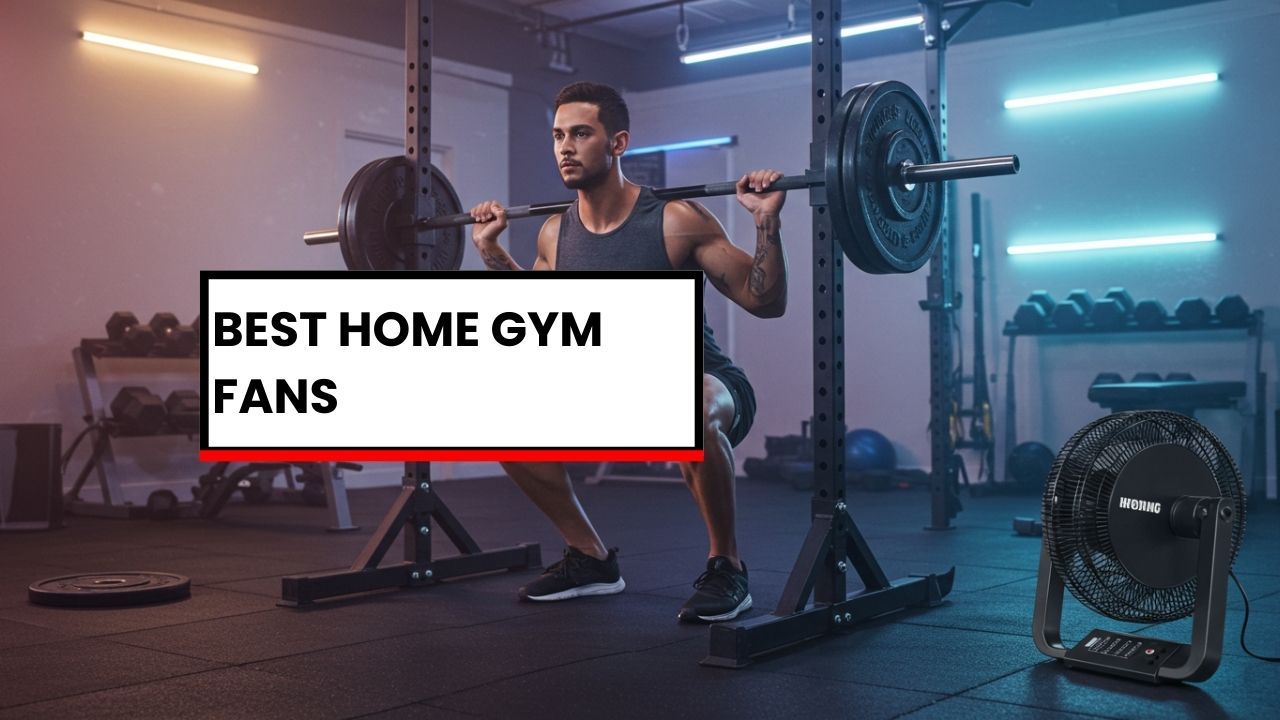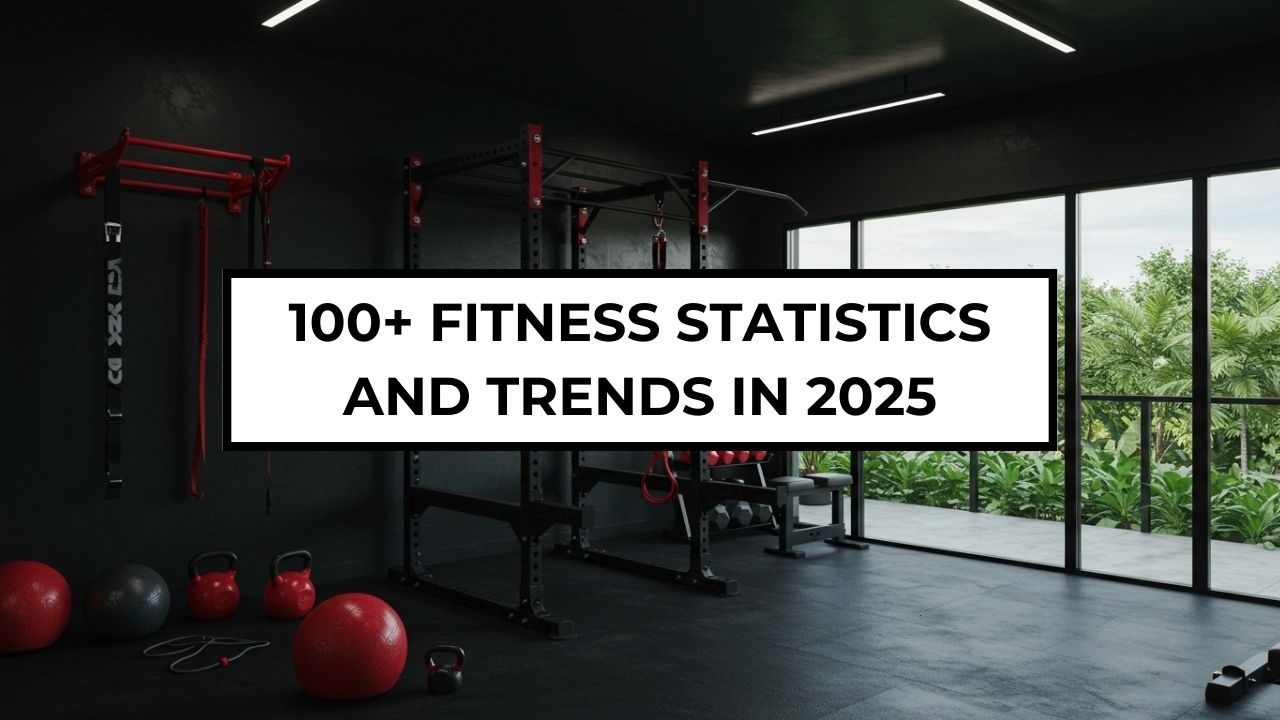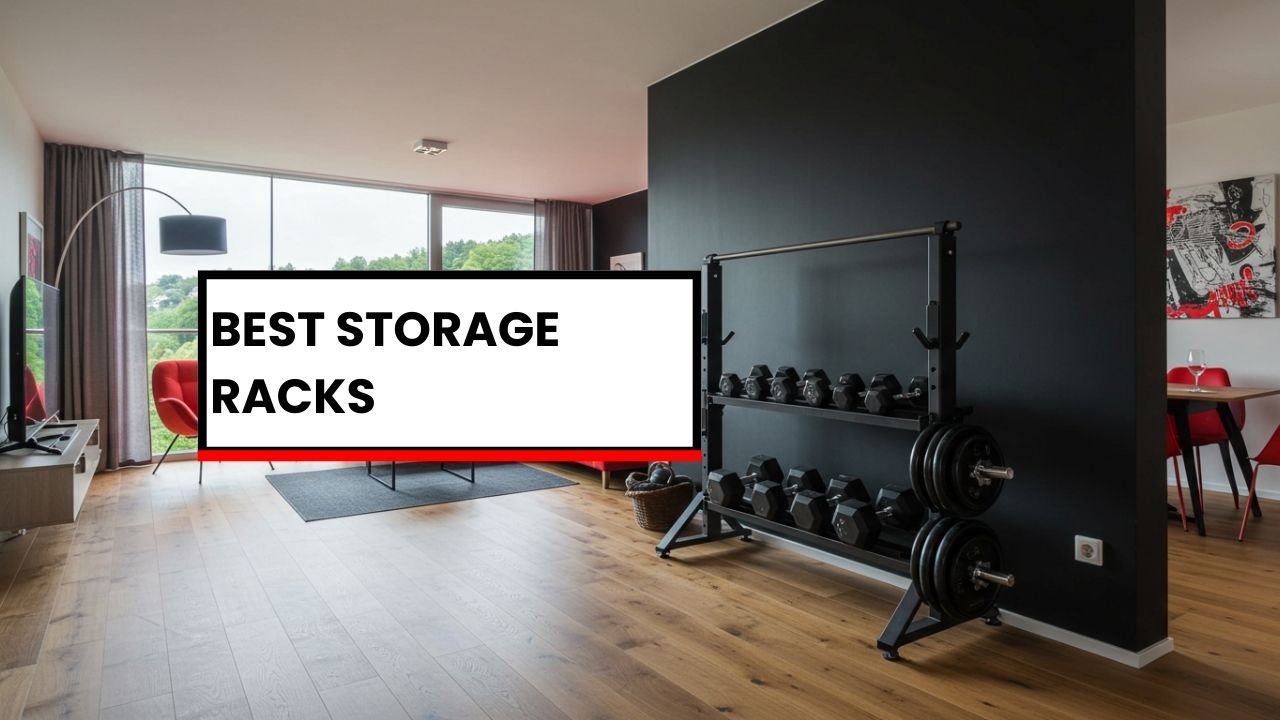Disclosure Information
This blog contains affiliate links. If you make a purchase through one of these links, our team may earn a commission at no extra cost to you. Learn more. Thanks for your support!
Working out at home offers convenience and privacy, but many home gyms suffer from poor air circulation. A stuffy, hot workout space can hamper your performance and make exercise uncomfortable.
Finding the right fan for your home gym can transform your workout environment, keeping you cool and focused through even the most intense sessions.
Proper airflow isn’t just about comfort; it’s about creating a healthier, more effective workout environment. This guide explores why ventilation matters. We’ll dive into the best home gym fans.
We’ll help you choose the perfect fan for your space, budget, and fitness goals. Let’s dive in!
The Quick Overview: Best Home Gym Fan Options Mentioned
- High-Velocity Floor Fan: Lasko High Velocity Pro-Performance Fan
- Large Air Circulator (Floor): Vornado 660
- Wall-Mounted Fan (Heavy Duty): Hurricane Pro High Velocity Oscillating Metal Wall Mount Fan
- Wall-Mounted Fan (Digital): Simple Deluxe 18″ Digital Wall Mount Fan
- Quiet Pedestal Fan: Rowenta Turbo Silence Extreme+ Stand Fan
- Standard Pedestal Fan: Lasko Elegance & Performance Pedestal Fan
- Compact Air Circulator: Vornado 460
- Overhead Solution: Ceiling Fans (various brands like Hunter, Minka Aire)
Why Proper Ventilation Matters in Your Home Gym
The Science Behind Workout Heat
When you exercise, your body temperature rises significantly. During intense workouts, your core temperature can increase by 2-3°F (source: Journal of Applied Physiology, 2023). This heat needs somewhere to go.
Without adequate airflow, heat and humidity build up quickly in enclosed spaces. This creates an environment that’s not only uncomfortable but potentially dangerous.
Performance Impact of Poor Ventilation
Poor air circulation directly affects your workout quality. Research shows that performance can decrease by up to 10% in hot, poorly ventilated spaces (source: International Journal of Sports Medicine, 2024).
When your body overheats, it diverts blood from your muscles to your skin. This reduction in muscle oxygen leads to earlier fatigue and decreased strength.
Health Considerations
Beyond performance, ventilation plays a crucial role in gym health. Proper airflow reduces exposure to airborne particles, decreases humidity, and prevents mold growth.
A study from 2023 found that home gyms without adequate ventilation had 65% higher concentrations of airborne particulates compared to well-ventilated spaces (source: Indoor Air Quality Journal, 2023).
Factors to Consider When Choosing a Home Gym Fan
Not all fans are created equal. Selecting the right one depends on your specific needs and space. Consider these factors before making a purchase.
Your Gym’s Size and Layout
A small corner gym has different needs than a large basement setup. Measure your workout area. Note ceiling height and any obstructions.
Larger spaces require fans with higher airflow capacity. Smaller spaces might benefit from compact or wall-mounted options. Consider where you need airflow most.
Fan Power (CFM)
CFM stands for Cubic Feet per Minute. It measures the volume of air a fan can move. Higher CFM generally means more powerful airflow.
Look for CFM ratings when comparing fans. For most home gyms, a fan with at least 500 CFM is a good starting point. Larger or hotter spaces may need 1000 CFM or more.
Noise Level (Decibels)
Some powerful fans can be quite loud. This might interfere with music, online classes, or concentration. Check the decibel (dB) rating if possible.
Quieter operation is often desirable. However, some people prefer the white noise powerful fans create. Balance your need for power with noise tolerance.
Fan Type
Different fan types offer unique benefits. We’ll explore floor, wall-mounted, pedestal, and air circulator fans in detail shortly. Think about which style best suits your space.
Features and Functionality
Consider extra features:
- Remote controls offer convenience.
- Timers can shut off the fan automatically.
- Oscillation spreads airflow over a wider area.
- Adjustable speeds provide flexibility.
- Smart features allow app or voice control.
Budget
Home gym fans range widely in price. Set a realistic budget. Balance cost with the features, power, and durability you need for effective cooling.
Types of Home Gym Fans & Top Recommendations
This is the core of our guide. Let’s explore the most common fan types suitable for home gyms. We’ll recommend some popular and effective models.
1. Floor Fans (High-Velocity Fans)
Floor fans are workhorses. They sit directly on the floor and often deliver powerful, directed airflow. Many are built with durable metal construction.
Benefits and Features
Floor fans represent the most versatile option for home gym setups. They offer powerful airflow while remaining portable and easy to position.
These fans typically feature adjustable height and tilt angles, allowing you to direct airflow precisely where needed. Many models include remote controls for convenience during workouts.
Best For
Floor fans work exceptionally well in medium to large home gym spaces. They’re ideal for strength training areas where you move between different stations or equipment.
Recommendation 1: Lasko High Velocity Pro-Performance Fan (Model U15617 or similar)
This fan is a popular choice for serious airflow. It offers durability and multiple speed settings. Its pivoting head directs air where needed.
| Feature | Detail | Notes |
| Type | High-Velocity Floor Fan | Powerful Air Mover |
| Key Feature | Pivoting Head | Direct Airflow Easily |
| Suitability | Medium/Large Gyms | Strong Cooling Needed |
Recommendation 2: Vornado 660 Large Air Circulator
While technically an air circulator, the 660 often functions like a premium floor fan. It uses signature Vortex Action for whole-room circulation, moving air up to 100 feet.
| Feature | Detail | Notes |
| Type | Air Circulator | Whole Room Circulation |
| Key Feature | Deep-Pitched Blades | Moves Air Effectively |
| Suitability | All Gym Sizes | Even Air Distribution |
2. Wall-Mounted Fans
These fans attach directly to the wall. They save valuable floor space, a huge plus in smaller home gyms. They provide consistent airflow from an elevated position.
Benefits and Features
Wall-mounted fans offer the perfect middle ground between floor and ceiling options. They save valuable floor space while providing directional airflow.
These fans typically oscillate to cover wide areas and come with remote controls for easy adjustment during workouts.
Best For
Wall fans are ideal for small home gyms or workout spaces with limited floor area. They work well alongside treadmills, exercise bikes, or rowing machines.
Recommendation 1: Hurricane Pro High Velocity Oscillating Metal Wall Mount Fan
Hurricane fans are known for rugged performance. This model offers oscillation, multiple speeds, and sturdy metal construction. Ideal for consistent overhead cooling.
| Feature | Detail | Notes |
| Type | Wall-Mounted Fan | Heavy-Duty Option |
| Key Feature | Oscillation | Wider Air Coverage |
| Suitability | Small to Medium Gyms | Permanent Installation |
Recommendation 2: Simple Deluxe 18″ Digital Wall Mount Fan
This option often includes digital controls and a remote. It provides convenience alongside space-saving benefits. Multiple speeds and oscillation are common.
| Feature | Detail | Notes |
| Type | Digital Wall Fan | Modern Features |
| Key Feature | Remote Control | Easy Adjustments |
| Suitability | Small/Medium Home Gyms | User-Friendly Choice |
3. Pedestal Fans
Pedestal fans stand on an adjustable pole. This allows you to change the height and direction of airflow easily. They often feature oscillation for wider coverage.
Benefits and Features
Pedestal fans combine the directional control of floor models with added height advantage. Their elevated position directs airflow at body level during workouts.
Most pedestal fans feature height adjustment from 3-5 feet, oscillation capabilities, and tilting heads. This versatility makes them particularly effective for cooling specific body zones.
Best For
Pedestal fans excel in medium-sized home gyms with varied equipment. They’re especially effective for cardio workouts where maintaining a consistent cooling breeze is essential.
Recommendation 1: Rowenta Turbo Silence Extreme+ Stand Fan
Rowenta is known for powerful yet quiet fans. This model often features multiple speeds, including a silent night mode and a turbo boost. Excellent airflow control.
| Feature | Detail | Notes |
| Type | Pedestal Fan | Quiet Performance |
| Key Feature | Low Noise Level | Minimal Distraction |
| Suitability | Any Gym Size | Noise-Sensitive Users |
Recommendation 2: Lasko Elegance & Performance Pedestal Fan
Lasko offers reliable pedestal fans at various price points. This type typically includes oscillation, adjustable height, and multiple speed settings. A solid all-around choice.
| Feature | Detail | Notes |
| Type | Pedestal Fan | Reliable Choice |
| Key Feature | Adjustable Height | Versatile Airflow |
| Suitability | Medium Gyms | General Purpose Cooling |
4. Air Circulators (High-Volume Low-Speed)
Distinct from standard fans, air circulators (like Vornado) focus on moving air throughout the entire room. They create a unique airflow pattern for consistent circulation.
Benefits and Features
HVLS fans represent the premium tier of gym ventilation. These massive fans move large volumes of air with minimal energy consumption.
With blade spans often exceeding six feet, these fans create gentle, consistent airflow throughout large spaces without the “wind tunnel” effect.
Best For
HVLS fans are ideal for garage gyms, commercial-level home setups, or multi-person workout spaces requiring consistent temperature control.
(See Vornado 660 recommendation under Floor Fans, as it excels in this category too).
Recommendation 1: Vornado 460 Compact Air Circulator
A smaller Vornado option, perfect for personal cooling or smaller spaces. It delivers the same Vortex technology in a more compact footprint. Easy to move around.
| Feature | Detail | Notes |
| Type | Compact Air Circulator | Small Space Solution |
| Key Feature | Vortex Technology | Efficient Circulation |
| Suitability | Small Gyms/Zones | Personal Cooling |
5. Mounted/Ceiling Fans
While requiring more permanent installation, ceiling fans offer excellent overhead air circulation. They distribute air evenly without taking up floor or wall space.
Benefits and Features
Wall-mounted fans offer the perfect middle ground between floor and ceiling options. They save valuable floor space while providing directional airflow.
These fans typically oscillate to cover wide areas and come with remote controls for easy adjustment during workouts.
Best For
Wall fans are ideal for small home gyms or workout spaces with limited floor area. They work well alongside treadmills, exercise bikes, or rowing machines.
Note: Specific ceiling fan recommendations depend heavily on room size, style preference, and features (like lights). Consider brands like Hunter, Casablanca, or Minka Aire. Consult installation requirements carefully.
Option 1: Air King Industrial Grade Wall Fan
- Three power settings with robust airflow
- 90-degree oscillation with adjustable tilt
- Metal construction built for longevity
- Simple installation with included hardware
Option 2: Hurricane Wall Mount Fan
- Three speeds with 90-degree oscillation
- Pull-chain operation with optional remote
- ETL safety certification
- Adjustable tilt for targeted cooling
Optimizing Fan Placement for Maximum Effectiveness
Where you place your fan significantly impacts its cooling effect. Don’t just stick it in a corner! Think strategically about airflow.
Create Cross-Ventilation
If possible, open a window or door. Place your fan to help pull fresh air in or push stale air out. This dramatically improves overall air quality.
Positioning a fan facing an open window can exhaust hot, humid air. Placing it near an opening to draw cooler air inwards also works well.
Target Your Airflow
Direct the fan towards your primary workout zone. If you use a treadmill most, aim the fan there. For floor exercises, adjust accordingly.
An oscillating fan helps cover a larger area. Pedestal and pivoting floor fans allow easy redirection as you move between different exercise routines.
Consider Workout Zones
Think about where you sweat the most. Aim the airflow directly at your body for maximum evaporative cooling. This is the most efficient way a fan cools you.
In larger gyms, you might even consider using multiple fans. One for overall circulation and another for targeted cooling during intense efforts.
Beyond Fans: Other Ways to Enhance Home Gym Ventilation
Fans are fantastic, but they work best as part of a broader ventilation strategy. Consider these additional elements.
Open Windows and Doors
The simplest method! Whenever weather permits, open windows or doors. Natural airflow is free and highly effective for refreshing the air.
Consider an Air Purifier
While fans move air, air purifiers actively filter it. They remove dust, pollen, pet dander, and even some odors or VOCs (Volatile Organic Compounds).
An air purifier complements a fan. The fan circulates air, helping the purifier capture more particles. This is great for allergy sufferers or dusty environments.
Use a Dehumidifier
If your home gym suffers from high humidity, a dehumidifier is essential. It removes excess moisture from the air. This makes the space feel cooler and prevents mold growth.
Lower humidity allows sweat to evaporate more easily. This enhances the cooling effect of your fan. Aim for a humidity level between 40-60%.
Choose Breathable Home Gym Flooring
Believe it or not, flooring matters. Materials like rubber can sometimes trap heat and moisture. Ensure your home gym flooring choice doesn’t hinder air quality.
Consider options known for better breathability or easy cleaning. Proper subfloor preparation can also play a role in moisture management.
Essential Fan Maintenance for Longevity
Keep your fan running efficiently and safely with simple maintenance. A clean fan performs better and lasts longer.
Regular Cleaning is Key
Dust accumulates quickly on fan blades and grills. This restricts airflow and can recirculate dust into your gym. Clean your fan regularly (monthly is ideal).
Unplug the fan first. Use a vacuum cleaner with a brush attachment, compressed air, or a damp cloth. Refer to the manufacturer’s instructions for specific cleaning guidance.
Check Connections and Cords
Periodically inspect the power cord and plug for any damage. Ensure wall-mounted fans are securely fastened. Listen for any unusual noises that might indicate a problem.
Conclusion
A high-quality home gym fan isn’t a luxury; it’s an investment. It boosts comfort, enhances performance, and creates a healthier workout environment. Ventilation is vital.
Consider your space, needs, and budget. Choose from floor, wall-mounted, pedestal, or air circulator types. Use our recommendations as a starting point for your search.
Place your fan strategically, keep it clean, and enjoy cooler, more productive workouts. Breathe easy, train harder, and make your home gym the best it can be!



